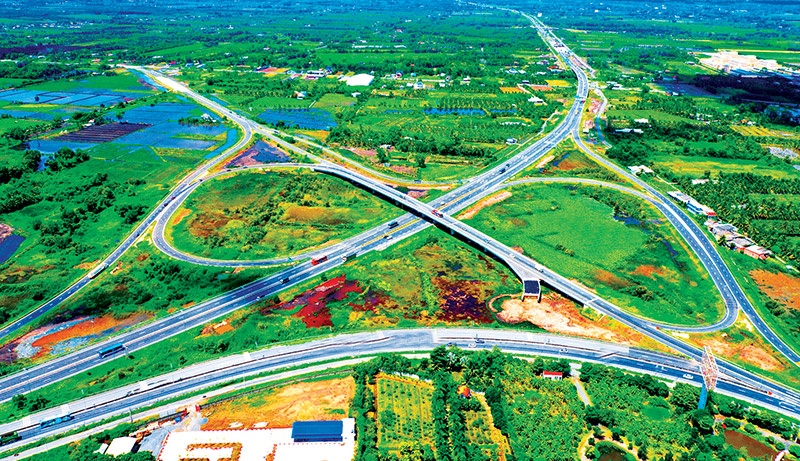Modern slant found through key planning
In the updated draft national master plan for the rest of the decade and with orientations to 2050 that was released last week, the section on the nation’s urban and rural network highlighted that Hanoi and Ho Chi Minh City are continuing to promote their effectiveness and spillover effects. It is hoped that they will develop dynamically and creatively in order to compete internationally.
 |
| Vietnam’s planning orientation for the next few years aims to push development of satellite towns, Le Toan |
At last week’s conference on the national master plan held by the Ministry of Planning and Investment in Hanoi, Tran Hong Quang, director general of the ministry’s Vietnam Institute for Development Strategies (VIDS), revealed that the two biggest cities will focus on developing high-quality and high-value-added services in sci-tech, health, training, and IT, as well as restricting processing and manufacturing industries that use a lot of land and labour.
“We should push the development of satellite towns for the mega-cities to reduce the stress on them and strengthen regional links,” said Quang.
It is hoped that in the coming decades, the capital of Hanoi will be developed into a rich living environment and landscape, featuring socio-cultural characteristics along with modern development trends.
In the draft plan, the greater Hanoi area will accelerate the development of the Red River Delta and the northern midlands and mountains, as well as develop provincial and specialised cities that will play a driving role in the region. This will be carried out on the back of strengthened transport links and the effective exploitation of belt roads 4 and 5, along with the utilisation of economic corridors such as Lao Cai-Hanoi-Quang Ninh, Hanoi-Haiphong-Quang Ninh, and Lang Son-Bac Giang-Hanoi.
Meanwhile, provincial cities and specialised urban centres in the south will also prove crucial in the region on the basis of strengthening links and effectively exploiting belt roads 3 and 4, as well as economic axes and corridors from Ho Chi Minh City to other localities.
“We will focus on developing the industrial chain of Moc Bai urban area to Ho Chi Minh City and Cai Mep-Thi Vai Port in association with the Trans-Asian economic corridor, as well as pour research into Long Thanh International Airport,” said Quang.
In addition, the Mekong Delta city of Can Tho and the central city of Danang will also be important areas for the future, according to the draft national master plan. Can Tho will become a regional centre for trade services, tourism, processing, high-tech agriculture, education and training, specialised healthcare, sci-tech, culture, and sports.
Meanwhile, Danang and its surrounding area will be orientated towards becoming a centre for entrepreneurship, innovation, tourism, commerce, finance, logistics, IT, high-quality education, and hosting regional and international events.
In the view of Pho Duc Tung, an expert from the World Bank Group, the two key urban areas of Hanoi and Ho Chi Minh City will eventually cover a population of 50 million people and contribute about half of the country’s total GDP. However, the most important aspect is developing inner strategic transport to connect other localities and the central cities to take advantage of the spillover effects.
“Unless the area’s links are ensured, people will gather in Hanoi and Ho Chi Minh City’s centres and cause overloading and other environmental issues. Moreover, the two economic corridors of Moc Bai-Ba Ria Vung Tau and Lao Cai-Haiphong-Quang Ninh would not be able to reap the full benefits,” said Tung.
To overcome the issues of population increase and pollution, Tung suggested developing connections between these cities and their urban satellite towns. “Meanwhile, satellite provinces and cities should be ready for a huge area of clean land and infrastructural development to build big industrial zones and urban industrial zones,” Tung added.
Quang from the VIDS also emphasised developing urban and rural areas in accordance with the distribution and development level of production. “This will help to meet the requirements of industrialisation, modernisation, and the international economic integration of Vietnam, allowing the country to develop a dynamic and sustainable economy by 2030.”
The draft national master plan highlighted developing and adequately distributing urban networks throughout the country, creating balanced and harmonious development among regions based on the carrying capacity of the environment, as well as focusing on urban-rural links.
“It is necessary to ensure that the urbanisation and formation of growth poles are suitable for the advantages of each region, promoting the role of major and megacities for the whole country while also remembering the importance of smaller regions and medium urban areas in each locality,” the master plan outlined.
What the stars mean:
★ Poor ★ ★ Promising ★★★ Good ★★★★ Very good ★★★★★ Exceptional
Latest News
More News
- Unlocking urban potential of smart cities (December 18, 2025 | 16:50)
- Green finance offers 'passport' for Vietnamese construction, building materials firms (December 15, 2025 | 08:00)
- Gamuda Land commit long-term investment (December 12, 2025 | 11:49)
- HITC ties up with Evolution to develop AI and hyperscale data centres in Vietnam (December 11, 2025 | 12:09)
- Real estate deals boom via high-profile names (December 08, 2025 | 11:32)
- Industrial segment shaped by M&As (December 08, 2025 | 08:00)
- The Privé sets the benchmark for luxury real estate (December 05, 2025 | 08:28)
- TD CASA and the rise of bespoke interior design in luxury living spaces (December 03, 2025 | 14:14)
- Lee Soo-man's Blooming Sky to build Gia Lai culture, sport, and entertainment complex (December 02, 2025 | 16:41)
- Sustainability in DNA of Keppel Vietnam's future urban development strategy (November 28, 2025 | 10:53)

 Tag:
Tag:














 Mobile Version
Mobile Version